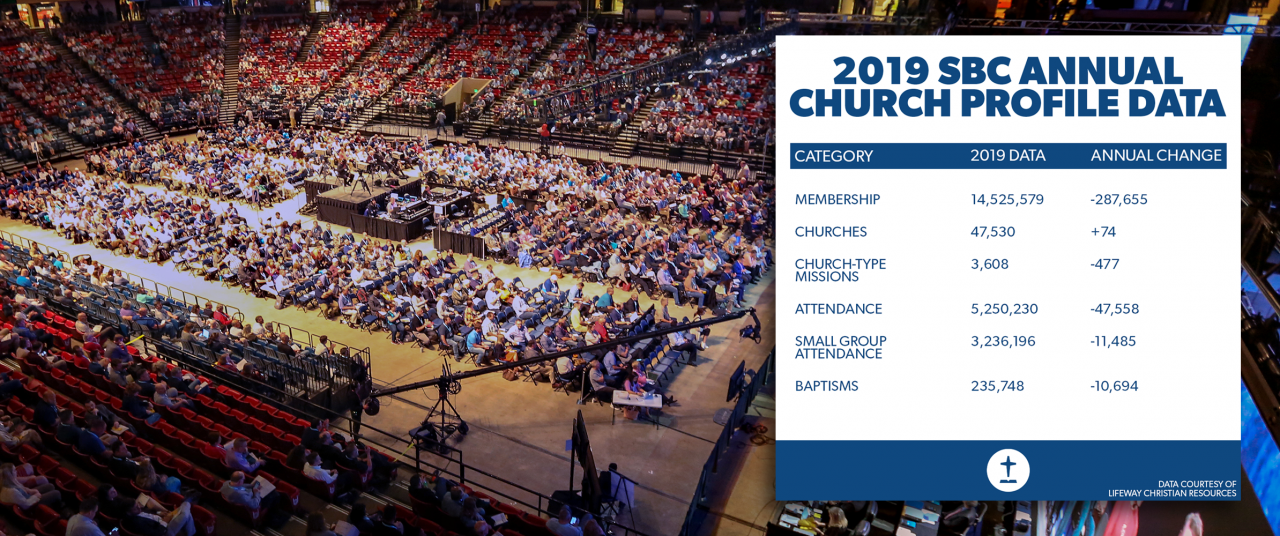NASHVILLE, Tenn. (BP)—For the 13th consecutive year, the Southern Baptist Convention (SBC) reported a drop in its membership. Total membership in the Southern Baptist Convention fell almost 2 percent to 14,525,579 from 2018 to 2019. The decline of 287,655 members is the largest single-year drop in more than 100 years.
While the statistical decline is concerning for the largest Protestant denomination in America, Ronnie Floyd, the SBC Executive Committee’s president and CEO, also expressed concern with the length of time and effort needed to collect information from cooperating churches, as well as the lack of uniformity, which combine to prevent a complete statistical picture of the denomination.
State conventions set their own procedures and timelines, which can range from several months to a year.
“In our high-tech world, our processes cannot have this much lag time,” Floyd said. “It simply cannot take this long and be this complicated. It is past time for us to rethink and re-innovate the SBC Annual Church Profile (ACP) process.”
According to LifeWay Research, only 75 percent of Southern Baptist congregations participated by reporting at least one item on the profile—which means 25 percent of Southern Baptist congregations did not report any items. The reporting rate is similar to previous years, but has steadily declined over the past two decades even as reporting technology has increased.
“We cannot possibly know how best to meet the needs of our 47,500 churches when we only receive needed data from just 75 percent of them,” Floyd said. “Uniformity in our data collection timing, uniformity of the questions asked of our churches, accelerating the response time and increasing the response rate are vitally important for us so that we will have accurate and current data regarding cooperating churches in the SBC.”
Floyd cautioned that “approximately 12,000 of our churches chose not to participate in any way in the ACP process,” adding: “That definitely impacts our statistical data.”
Scott McConnell, executive director of LifeWay Research—which is charged with compiling the report in cooperation with Baptist state conventions—also noted that, for the first time in 100 years, a state convention did not collect total membership numbers. An estimate for Oklahoma congregations is included in the data based on previous reporting from current congregations.
Nathan Lorick, executive director of the Colorado Baptist General Convention, stressed the importance of churches reporting the data needed by states and national organizations in order to better serve churches.
“Churches that report their ACP numbers are not only joining with others across their state to celebrate what God is doing; they are also helping their convention be more strategic in equipping churches to engage their communities,” Lorick said. “ACP reporting gives Southern Baptists the opportunity to learn what areas we need to be more focused on in order to see the Gospel advance like never before.”
McConnell also emphasized the importance of these cooperative connections within the SBC—especially during a global pandemic.
“The Annual Church Profile is an important annual check-in to make sure other congregations, associations, state conventions and national entities have the contact information, leadership names and a few statistics to stay connected with a congregation,” McConnell said. “Many contacts have been made during this difficult time that were only possible because information was updated and stored in a national database.”
One statistical positive was the number of churches cooperating with the SBC. Church totals grew slightly to 47,530, an increase of 74 from 2018. However, the number of church-type missions fell by 477 to bring the overall number of SBC congregations down to 51,138 in 2019. Multisite congregations reported an additional 505 campuses where local church ministry takes place.
State-level highlights
While the national numbers declined, several state conventions saw growth, particularly some outside of the traditional Bible belt.
Colorado, Hawaii-Pacific, Iowa, Minnesota-Wisconsin, Northwest, Puerto Rico, and Utah-Idaho Baptist conventions all reported a more than 30 percent increase in baptisms for 2019.
“We are humbled and excited to see Colorado Baptists’ baptism numbers increase for the third year in a row,” Lorick said. “Our churches are fully committed to see the Gospel advance across our state. Through pastors leading well, people engaging the lost, churches faithfully reporting and Colorado Baptists’ strategic ‘Next Step’ process, God has given a great increase. We are so grateful for all God is doing and look forward to all he will do!”
Florida reported the most baptisms by a single convention with 25,338, while neighboring Georgia had the largest numerical increase with 1,901 more baptisms in 2019 than 2018 (19,641 to 17,740).
“This (increase) is a reflection of the commitment of our pastors to reaching the Georgia with the Gospel,” said Thomas Hammond, Georgia Baptist executive director. “It shows they are focused and passionate in leading their churches to reaching their community and mission field.”
Congregations in the Hawaii-Pacific, Iowa and Michigan state conventions grew membership by more than 20 percent in 2019. Kentucky had the largest numerical membership jump, adding 42,315 people to their congregations last year.
Attendance drops
In addition to the decrease in membership, average weekly worship service and Sunday School or small group attendance each dropped by less than 1 percent. Average worship service attendance fell to 5,250,230, while average small group attendance declined to 3,236,196.
Total baptisms fell by more than 4 percent, dropping from 246,442 in 2018 to 235,748 in 2019. In 2019, there was one baptism for every 62 Southern Baptists.
“These numbers are not able to tell the story of all the evangelistic efforts that many individuals and churches have put in this past year,” McConnell said. “They do indicate, however, that the efforts of the same number of people in a congregation on average are seeing fewer people come to Christ and being baptized.
“The Southern Baptist Convention is not immune to the increasing secularization among Americans that is seen in more of our children and our neighbors not having interest in coming to Jesus.”
An evangelism task force was formed in 2017 and gave a report with recommendations at the 2018 SBC Annual Meeting in Dallas. Recommendations from the task force included churches conducting annual evangelism training events and adopting baptism goals as well as pastors modelling personal evangelism and presenting public Gospel invitations. Matt Queen, professor of evangelism at Southwestern Seminary, served on the task force.
“Those recommendations have not yet reversed our baptism decline,” Queen said. “I continue to believe wholeheartedly that these recommendations, if practiced by Southern Baptists, can become a catalyst that God might use to see an increase in disciples made both here and around the world.”
Declines in giving
Total church receipts and undesignated receipts were both down in 2019 after two years of growth. Total church receipts reported through the ACP fell 1.44 percent to $11.6 billion. Undesignated church receipts decreased 0.01 percent to $9.6 billion.
Congregations reported total mission expenditures of $1.1 billion and Great Commission Giving of $541 million.
Giving through the SBC’s Cooperative Program is not included in the ACP statistical summary. Actual giving totals are available through Baptist state conventions and the SBC Executive Committee, which processes the mission gifts.
Individual congregations voluntarily report their ACP data to their local Baptist associations and/or their state conventions, and the data is released when all cooperating state conventions have reported.






